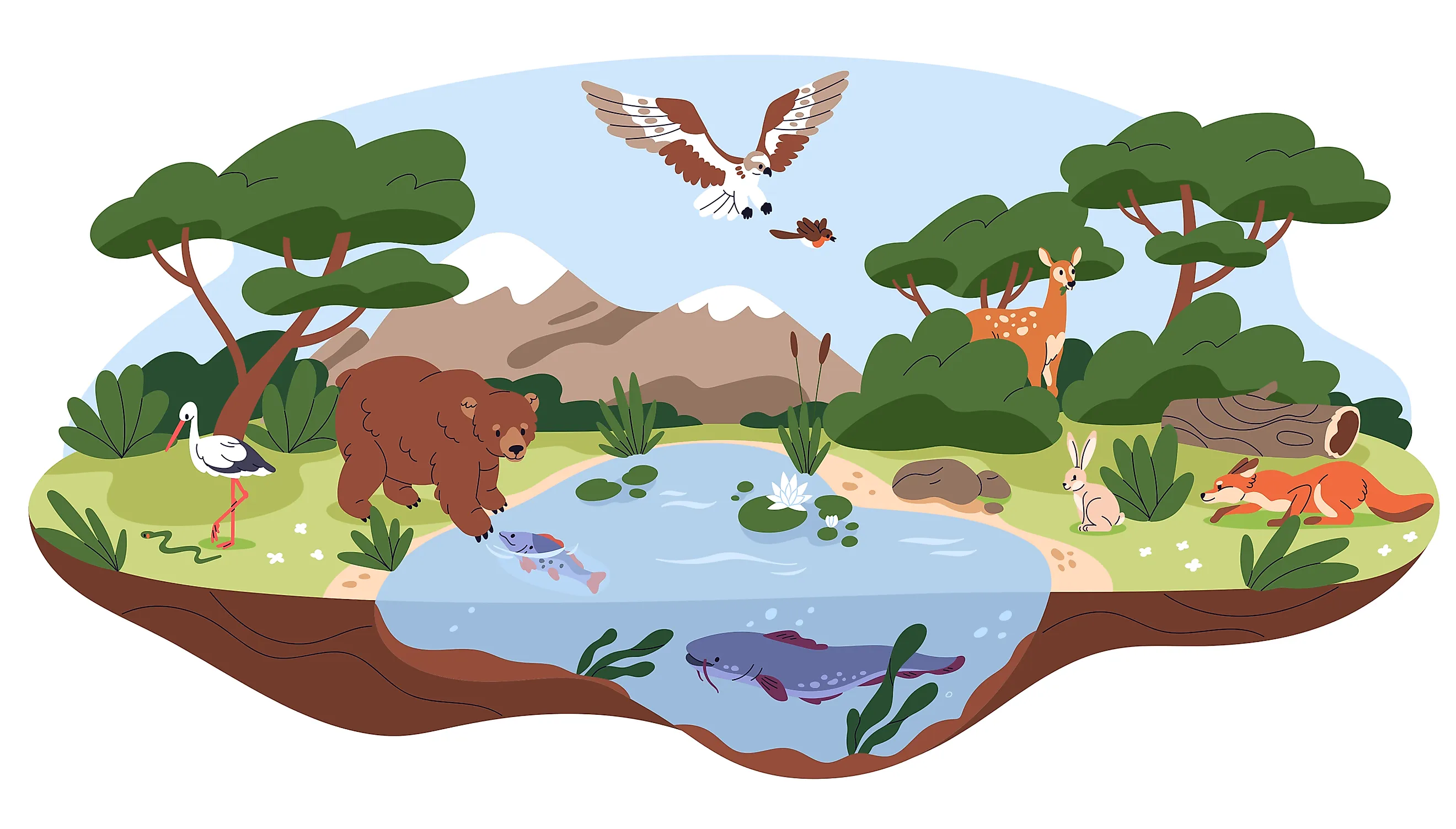
The biosphere, a term coined by geologist Eduard Suess in 1875, refers to the zone on Earth where life exists. It encompasses all ecosystems, organisms, and their interactions with the environment. While most people are familiar with the concept of the biosphere, there are numerous surprising facts that highlight the extraordinary nature of this complex system. From unique adaptations to mind-boggling statistics, the biosphere offers a plethora of intriguing discoveries. In this article, we will explore 19 surprising facts about the biosphere that will not only pique your curiosity but also deepen your understanding of the delicate web of life on our planet.
Key Takeaways:
- Biosphere 2 in Arizona is a cool place with mini rainforests, deserts, and oceans. It helps scientists study climate change, sustainable agriculture, and even space exploration. It’s like a real-life science fiction adventure!
- Biosphere 2 is like a giant science experiment that teaches us about ecosystems and sustainability. It’s also a fun place to visit and learn about the environment. Who knew science could be so cool?
Biosphere 2 is a unique research facility.
Biosphere 2, located in Arizona, is an innovative research facility that consists of various ecosystems sealed under glass domes. It was designed to study the interactions between organisms and their environment.
Biosphere 2 has its own mini rainforest.
Within Biosphere 2, there is a 1.27-acre rainforest biome that replicates the conditions of a tropical rainforest. It contains a diverse array of plant and animal species, creating a self-sustaining ecosystem within the facility.
Biosphere 2 has been used to study climate change.
Scientists at Biosphere 2 have conducted experiments to understand how ecosystems respond to changes in atmospheric conditions, such as elevated carbon dioxide levels and temperature increases. These studies provide valuable insights into the potential effects of climate change.
Biosphere 2 holds several world records.
Biosphere 2 holds several Guinness World Records, including the largest fully enclosed greenhouse and the largest closed ecological system.
Biosphere 2 was the subject of an experimental mission.
In 1991, eight people lived inside Biosphere 2 for two years as part of an experiment to test the feasibility of self-sufficient human habitation in a closed system. The mission aimed to simulate living on another planet and explore the challenges of long-duration space travel.
Biosphere 2 has different biomes.
Within the facility, there are several distinct biomes, including a desert, savannah, ocean with a coral reef, mangrove wetlands, and agricultural areas. These biomes allow scientists to study a wide range of ecosystems and their interactions.
Biosphere 2 has faced challenges.
The original mission inside Biosphere 2 experienced several difficulties, including low oxygen levels and issues with crop production. These challenges highlighted the complexity of maintaining a closed ecological system and provided valuable lessons for future research.
Biosphere 2 is now utilized for various research purposes.
Today, Biosphere 2 is used for a wide range of research projects, including studies on sustainable food production, ecological restoration, and the impacts of climate change on different ecosystems.
Biosphere 2 is an educational resource.
In addition to scientific research, Biosphere 2 serves as an educational resource for students and visitors. It provides a unique opportunity to learn about the interconnectedness of ecosystems and the importance of environmental stewardship.
Biosphere 2 has inspired eco-architectural designs.
The innovative design of Biosphere 2, with its self-sustaining ecosystems and controlled environments, has inspired architects and engineers to explore new possibilities in eco-friendly and sustainable building designs.
Biosphere 2 is an important tool for studying biodiversity.
Scientists use Biosphere 2 to study the impacts of changing environmental conditions on biodiversity. By monitoring and analyzing the interactions between different species within the facility, researchers can gain insights into the dynamics of ecosystems in the face of environmental challenges.
Biosphere 2 has contributed to advancements in sustainable agriculture.
Through experiments conducted within Biosphere 2, scientists have developed innovative techniques for sustainable agriculture, such as vertical farming systems and aquaponics, which can help address food security challenges in an environmentally friendly manner.
Biosphere 2 has a unique water recycling system.
To maintain the closed ecological system, Biosphere 2 utilizes a sophisticated water recycling system that collects, treats, and recycles wastewater. This system helps conserve water resources and promotes sustainability.
Biosphere 2 provides insights into the future of space exploration.
The research conducted in Biosphere 2 has provided valuable insights into the challenges of long-duration space missions and the potential for self-sustaining habitats on other planets. These findings contribute to ongoing discussions on the future of space exploration.
Biosphere 2 is a popular tourist attraction.
Biosphere 2 attracts thousands of visitors each year who come to explore the unique facility and learn about its groundbreaking research. The facility offers guided tours and educational programs for visitors of all ages.
Biosphere 2 has supported collaborative research projects.
Scientists from multiple disciplines and institutions collaborate at Biosphere 2 to conduct interdisciplinary research projects. This collaborative approach encourages knowledge sharing and fosters innovative solutions to complex environmental challenges.
Biosphere 2 promotes environmental awareness.
By showcasing the intricate balance of ecosystems and the importance of environmental stewardship, Biosphere 2 raises awareness about the need to protect and preserve our planet’s biodiversity and natural resources.
Biosphere 2 serves as a living laboratory.
With its controlled environments and diverse ecosystems, Biosphere 2 offers scientists a unique opportunity to conduct experiments and gather data in a real-world setting. This living laboratory provides invaluable insights into ecological processes and ecosystem dynamics.
Biosphere 2 continues to push boundaries in ecological research.
As a pioneering facility, Biosphere 2 remains at the forefront of ecological research. Scientists are continuously exploring new avenues of investigation and pushing the boundaries of knowledge to better understand our planet’s ecosystems and their interconnectedness.
Conclusion
In conclusion, the biosphere is a remarkable and intricate system that supports and sustains life on our planet. From its diverse ecosystems to its essential functions, the biosphere plays a vital role in maintaining the delicate balance of life. We have explored 19 surprising facts about the biosphere, highlighting its incredible complexity and resilience.By understanding more about the biosphere, we can appreciate the interconnectedness of all living organisms and the importance of preserving and protecting our natural environments. From the astounding biodiversity found in rainforests to the astonishing adaptations of organisms in extreme conditions, the biosphere never fails to amaze us.As we continue to uncover more about the biosphere and its intricate workings, let us strive to be responsible stewards of our planet. By taking actions to reduce our environmental impact, conserve resources, and raise awareness about the importance of biodiversity, we can ensure a sustainable future for generations to come.
FAQs
1. What is the biosphere?
The biosphere refers to the zone on Earth where life exists, including the atmosphere, lithosphere, and hydrosphere.
2. How does the biosphere support life?
The biosphere provides essential resources such as air, water, and nutrients required for organisms to survive and thrive.
3. What are some examples of ecosystems within the biosphere?
Examples of ecosystems within the biosphere include forests, grasslands, deserts, oceans, and wetlands.
4. What is biodiversity and why is it important?
Biodiversity refers to the variety of living organisms in a specific area. It is important because it contributes to ecosystem stability, resilience, and provides various benefits to humans.
5. How does the biosphere regulate climate?
The biosphere plays a crucial role in regulating climate through processes such as the carbon cycle, water cycle, and photosynthesis.
6. How do human activities impact the biosphere?
Human activities such as deforestation, pollution, and climate change can have detrimental effects on the biosphere, leading to loss of biodiversity and habitat destruction.
7. Can the biosphere recover from environmental damage?
The biosphere has a remarkable ability to recover from environmental damage, given the right conditions and sufficient time for natural processes to occur.
8. What are some conservation measures to protect the biosphere?
Conservation measures include creating protected areas, sustainable resource management, promoting renewable energy, and raising environmental awareness.
Biosphere 2's groundbreaking research has shed light on our planet's complex ecosystems, but there's still so much more to explore! If you're curious about other incredible biosphere reserves around the world, we've got you covered. From the lush forests of the Great Nicobar Biosphere Reserve to the unique wonders of Gunica Biosphere Reserve, these protected areas hold countless surprises. And if you're eager to learn even more captivating facts about biospheres in general, we've got an article that will satisfy your curiosity. Get ready to be amazed by the incredible diversity and importance of these vital ecosystems!
Was this page helpful?
Our commitment to delivering trustworthy and engaging content is at the heart of what we do. Each fact on our site is contributed by real users like you, bringing a wealth of diverse insights and information. To ensure the highest standards of accuracy and reliability, our dedicated editors meticulously review each submission. This process guarantees that the facts we share are not only fascinating but also credible. Trust in our commitment to quality and authenticity as you explore and learn with us.


